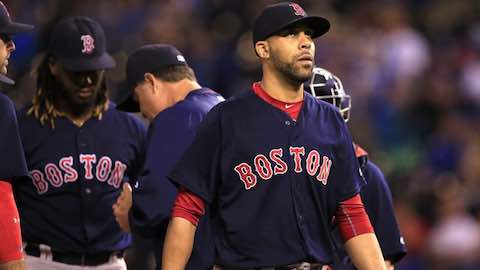- MENU
- HOME
- SEARCH
- WORLD
- MAIN
- AFRICA
- ASIA
- BALKANS
- EUROPE
- LATIN AMERICA
- MIDDLE EAST
- United Kingdom
- United States
- Argentina
- Australia
- Austria
- Benelux
- Brazil
- Canada
- China
- France
- Germany
- Greece
- Hungary
- India
- Indonesia
- Ireland
- Israel
- Italy
- Japan
- Korea
- Mexico
- New Zealand
- Pakistan
- Philippines
- Poland
- Russia
- South Africa
- Spain
- Taiwan
- Turkey
- USA
- BUSINESS
- WEALTH
- STOCKS
- TECH
- HEALTH
- LIFESTYLE
- ENTERTAINMENT
- SPORTS
- RSS
- iHaveNet.com: Baseball

The Boston Red Sox signed David Price with the hope he'd be the team's undisputed ace. He's experienced a slow start, but is it time for fans to panic?
Through his first 13 starts of the 2016 season, David Price boasts a 7-3 record for the Boston Red Sox. He's receiving the 10th-most run support per start of any pitcher in the Majors at an even six runs per outing -- and he's needed every bit of that offensive lift.
During the winter, new president of baseball operations Dave Dombrowski made a huge splash by signing Price to a whopping seven-year, $217 million contract to be Boston's new ace. The Red Sox expected the 2012 AL Cy Young award winner to continue dominating and anchor a staff that finished 25th in ERA a season ago. But while Price's run support (and subsequent win-loss record) are sterling, he sports a career-worst 4.63 ERA and a 1.18 WHIP (third-worst of his career).
Those figures certainly aren't ideal, but there are many layers to Price's first campaign suiting up for Red Sox Nation. PointAfter unpacked the southpaw's eyebrow-furrowing start to the 2016 season.
The Good
ERA is still a mainstay statistic that measures a pitcher's ability to prevent runs. That being said, it can also be rather misleading in some instances.
The fielding independent pitching metric, on the other hand, aims to improve ERA by measuring what a pitcher's ERA would be with league-average fielding behind him. Price's FIP of 3.54 suggests he's been a superior pitcher this season than his ERA would hint.
Price's ERA sits more than a full run worse than his FIP. That figure indicates Price has been somewhat unlucky on the mound this year. Out of the top 100 starting pitchers ranked by FIP, only 10 have a greater difference between FIP and ERA compared to Price (including Michael Pineda, Dallas Keuchel and Adam Wainwright, among others).
Other positive signs for Price include his strikeout and walk rates. His K/9 of 9.79 is well above his career average of 8.63, and while his BB/9 is somewhat elevated, it's nothing to cause alarm bells.
Price is giving up more runs than he's used to, but he's missing bats with regularity as well -- an odd combination once again hinting that the ace should return to a semblance of normalcy.
But let's look at the opposite side of the coin.
The Bad
Price has surrendered 10 home runs this season in 83.2 innings pitched. For a frame of reference, the Vanderbilt product gave up 17 dingers in 220.1 innings all of last season split between Detroit and Toronto. His HR/9 of 1.08 is his worst mark since 2009.
It's a problem that's likely tied to hitters squaring up on Price's mistakes.
According to FanGraphs, the hard-hit percentage by batters against Price is 34.8 percent. That's by far the highest percentage surrendered by Price in his career -- well above his career mark of 27.1 percent.
Additionally, the line-drive percentage from opposing hitters sits at a career-worst 25.1 percent against Price this season. That's a deadly combination for a pitcher when opposing bats are continually hitting frozen ropes into the gaps (or over the fence).
On top of everything, Price has seen his pitch velocity diminish across the board compared to a season ago.
After averaging 94 mph on his heater a season ago, Price's fastball has only been 92.4 mph on average for Boston. The velocity drop isn't exclusive to his cheddar, however, as every other pitch in his arsenal hasn't packed as much of a punch.
The Synopsis
Watching Price pitch, it's clear the veteran tends to miss location. When catchers set up on the inside edge to right-handers, Price will fly open and miss location high and outside. Historically, Price's stuff has been more than good enough to get away with those types of mistakes. But with the dip in velocity, opposing hitters have more time to punish those miscues.
On the bright side, Price's K/9, BB/9 and FIP all indicate he's still the elite pitcher he's always been.
So long as Price starts keeping the ball down in the zone to limit home runs and perhaps mix his pitches even more than he has been to account for the velocity dip, he should be just fine.
The Red Sox have pitching issues that go far beyond their $200+ million investment. It's not time to panic on Price, as there's enough on both ends of the spectrum to indicate a return to the norm. But as of June 9, Boston's team ERA of 4.32 ranks 20th in the league. That needs to be addressed somehow before the postseason push.
Article: Copyright ©
Baseball: "Should Red Sox Fans Be Worried About David Price?"